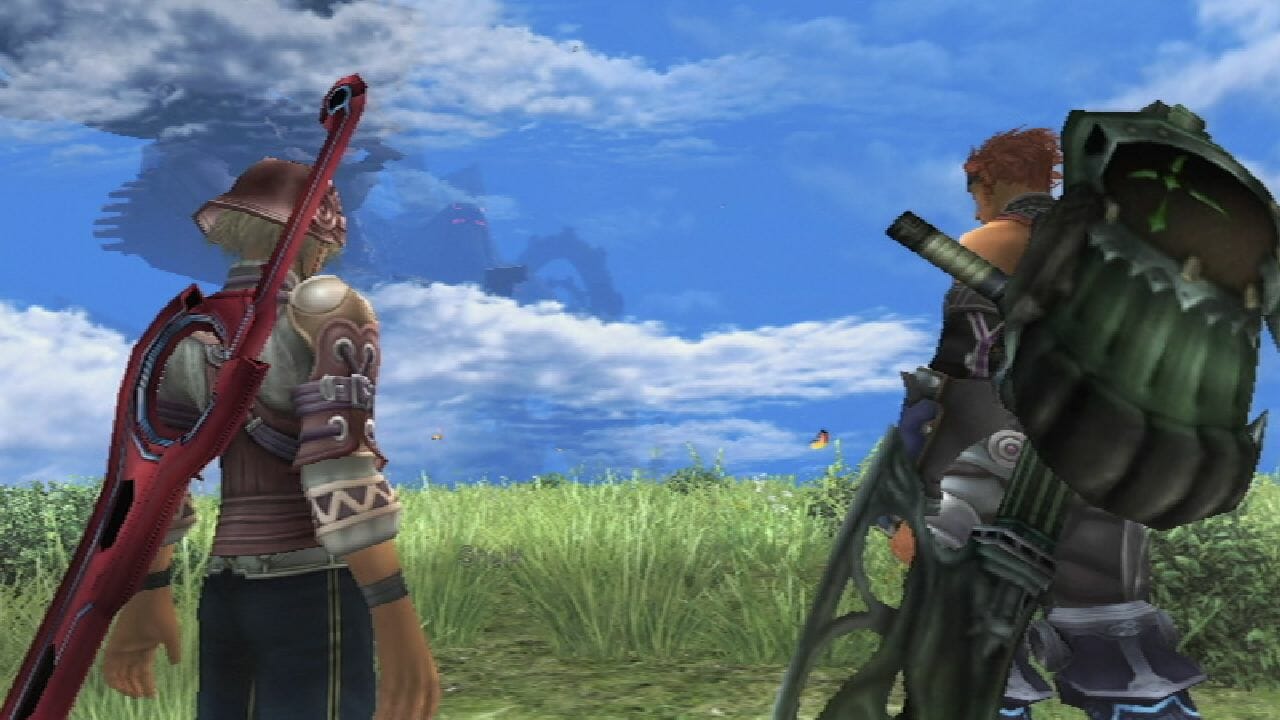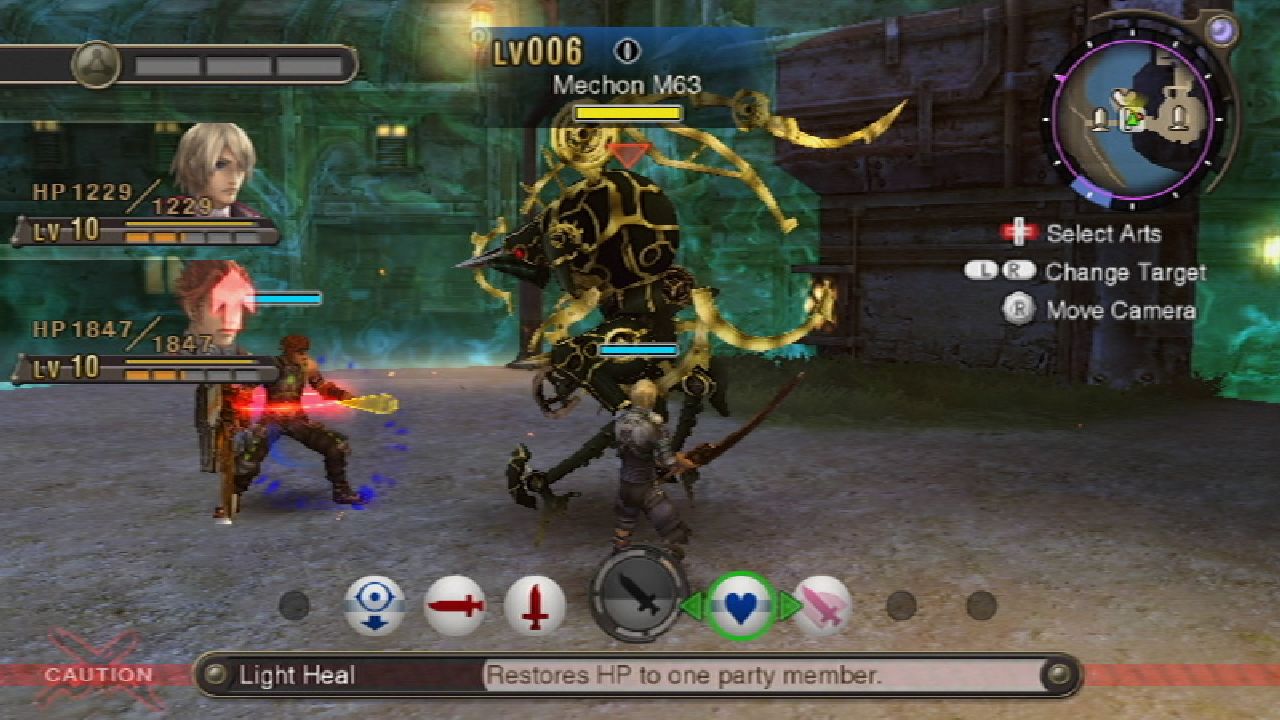
I’m glad Xenoblade Chronicles is on the Wii. If it were on the 360 or the PS3, then you could see my achievement list (Xenoblade Chronicles has achievements, which give you an experience point boost for unlocking them) and realize that I haven’t finished this game.
I’ve heard estimates of 100 hours of play from folks who have actually played it, not marketing copy. See, game length is a selling point; it’s shorthand for the potential of the game’s experiences to hold your attention, either with depth or with variety. Or for the obsessive-compulsive tendencies of the player, depending on who you ask.
Usually games of that length have a pacing problem, slow starts excused by the faithful with a “Well, it gets really good about twenty hours in.” Which, to the unconvinced, sounds like a rationalization: maybe it just took twenty hours to convince yourself you were having fun?
Early combat in Xenoblade Chronicles seems empty. You feel like you might be in for one of those slogs. But maybe you’ve been stressed out and you need something to think about and puzzle through, keeping your minds and your hands occupied. You target an enemy and then position your character on the battlefield (in real-time) and they’ll auto-attack as long as the opponent is in range. It feels like a snide comment on JRPG combat, the constant mashing of the “attack” button. But then as it layers on more and more systems — special abilities that stack for extra damage, or that cause specific effects if done in a certain order, weird social encouragement systems that increase characters’ fighting abilities – you start to realize that the auto-attack isn’t a criticism at all. It frees you up to be more strategic in the real-time combat because you’re not mashing the A button.
About that social encouragement system – as you move through the game’s world (on the inert bodies of two giant titans), the characters in your party will begin to like each other more and more. The closer two characters are, the more of each others’ skills they can equip. And they’ll banter more in battle (the battle barks, while not especially varied, are almost all shouts of encouragement to the other party members). Occasionally a timed button prompt will allow you to trigger one, providing both in-combat bonuses and strengthening the affinity between party members. Doing quests levels up your affinity within an area, which unlocks more quests. Talking to people adds them to a relationship tree which graphically represents the interpersonal dynamics of towns and cities.
And there’s crafting.
There’s lots of fast-traveling in the game. Each area is huge and allows for plenty of exploration, but there’s not a contiguous map of the world that you traverse, abstracting the actual land you walk on, like many other JRPGs. In those games you’re cut off from where you’ve come from, either by something blocking your path back or just the amount of time investment it would take to backtrack and then return to where you are now. Then, later in the game, you roll back into town in your new airship (always an airship, because you have to be pulled back from the map a bit, now that you’re protected from attacks and can go almost anywhere almost instantly), your characters’ increased maturity on display in their ability to easily destroy the enemies in the starting area that gave them so much trouble.

Allowing the player to instantly travel to almost any landmark at almost any point disconnects character growth from distance from home. Free of that metaphor, the game can include a mix of enemies of different difficulty in each area. No matter where you go, you will almost always be able to find a combat challenge. Most enemies will not attack you unless you engage them first; the ones that will auto-attack begin to ignore you once your characters are a high enough level. It’s great: if you’re significantly stronger than the monsters in a given area, you won’t be subject to multiple irritating battles where you’re guaranteed victory and almost no reward.
It’s dense: the first twenty hours are the constant layering of system upon system. You’re always figuring out something new.
Early on, the main character gains the ability to see into the future. This foreshadowing mechanic is used in cutscenes to show you glimpses of characters not yet met and events not yet happened, but it’s also used in combat and in exploration. All the color drains out of the world in a flash and an enemy’s massive attack will happen; the game will show you which party member is targeted and how much damage will be done. After seeing one of these deadly premonitions, a timer begins counting down to the attack, giving you the chance to block it with a special shield power, defeat the enemy, run away, or tell one of your party members to use one of their special moves.
If you pick up an item that will be a part of a quest later in the game (never a story quest, always a side quest involving collecting items for someone), a brief scene will show one of your party members talking to him or herself about who needs it, and why. The item will be marked as a quest item in your inventory, so you can remind yourself to not sell it or to give it to one of your other party members to increase affinity. It lightens your cognitive load when dealing with your large, unwieldy inventory of random junk because at least you know what stuff is important.
Oh, Xenoblade Chronicles inventory system: you do not want to make things easier for your players. You want us to spend time with you, to be a little confused at where things are equipped, at how things compare. Where in combat, the rest of the party is content to do their own thing, you demand constant input from us. You’ll not autoequip the best gear. And so your clunkiness becomes part of the rhythm of the game.
Which is: cutscene, conversation, combat, exploration, menu, repeat. Xenoblade Chronicles shifts between these well in those first twenty hours, becoming denser and denser, keeping you engaged by always giving you something new, something to look at, something to do. It’s the kind of pace that, if you surrender to it, makes 100 hours not seem like very much time at all.
Xenoblade Chronicles was developed by Monolith Soft and published by Nintendo. It is available for the Nintendo Wii.
Brian Taylor really wanted to write about how weird the relationship between videogames and time is, but decided he’d tweet about it instead.